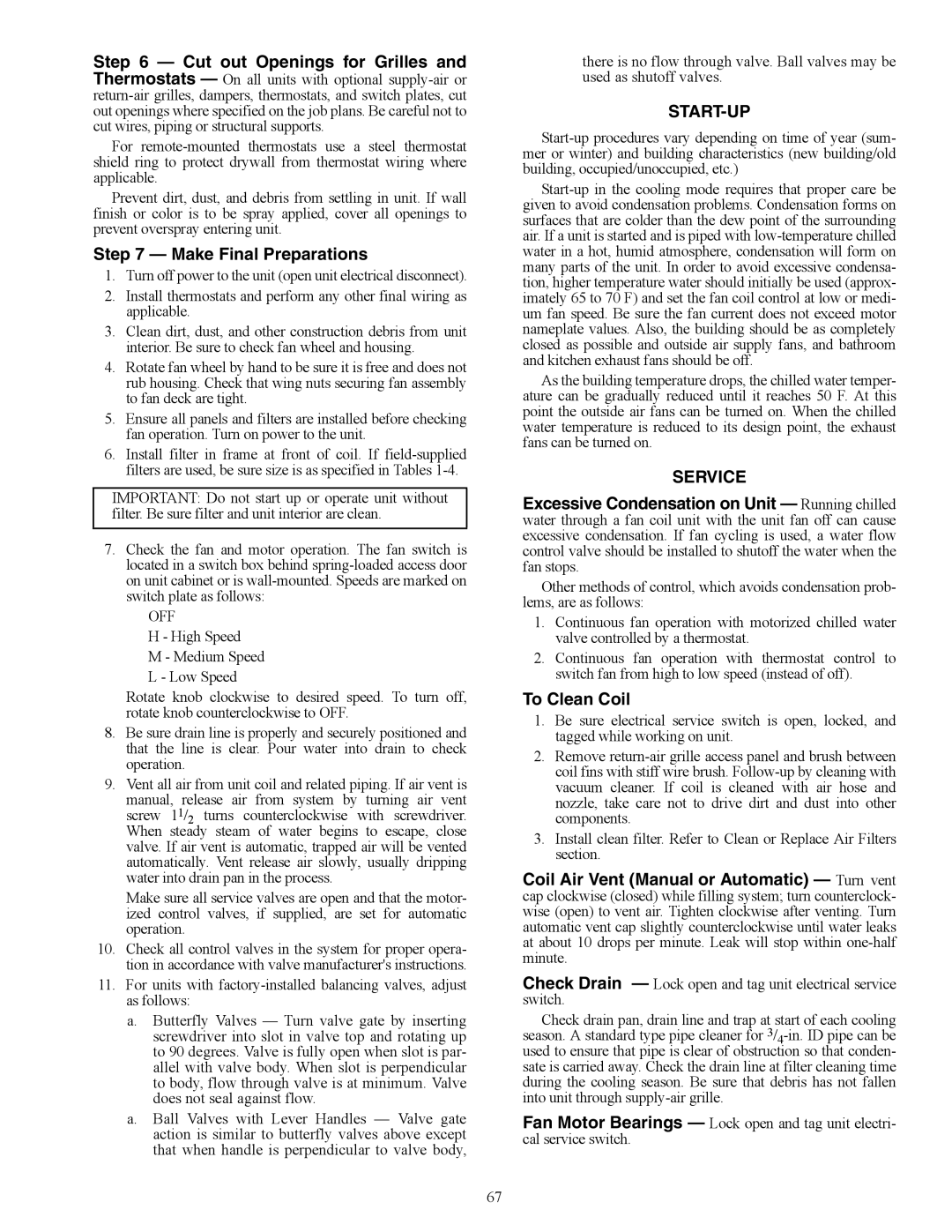Step 6 — Cut out Openings for Grilles and Thermostats — On all units with optional supply-air or return-air grilles, dampers, thermostats, and switch plates, cut out openings where specified on the job plans. Be careful not to cut wires, piping or structural supports.
For remote-mounted thermostats use a steel thermostat shield ring to protect drywall from thermostat wiring where applicable.
Prevent dirt, dust, and debris from settling in unit. If wall finish or color is to be spray applied, cover all openings to prevent overspray entering unit.
Step 7 — Make Final Preparations
1.Turn off power to the unit (open unit electrical disconnect).
2.Install thermostats and perform any other final wiring as applicable.
3.Clean dirt, dust, and other construction debris from unit interior. Be sure to check fan wheel and housing.
4.Rotate fan wheel by hand to be sure it is free and does not rub housing. Check that wing nuts securing fan assembly to fan deck are tight.
5.Ensure all panels and filters are installed before checking fan operation. Turn on power to the unit.
6.Install filter in frame at front of coil. If field-supplied filters are used, be sure size is as specified in Tables 1-4.
IMPORTANT: Do not start up or operate unit without filter. Be sure filter and unit interior are clean.
7.Check the fan and motor operation. The fan switch is located in a switch box behind spring-loaded access door on unit cabinet or is wall-mounted. Speeds are marked on switch plate as follows:
OFF
H - High Speed M - Medium Speed L - Low Speed
Rotate knob clockwise to desired speed. To turn off, rotate knob counterclockwise to OFF.
8.Be sure drain line is properly and securely positioned and that the line is clear. Pour water into drain to check operation.
9.Vent all air from unit coil and related piping. If air vent is manual, release air from system by turning air vent screw 11/2 turns counterclockwise with screwdriver. When steady steam of water begins to escape, close valve. If air vent is automatic, trapped air will be vented automatically. Vent release air slowly, usually dripping water into drain pan in the process.
Make sure all service valves are open and that the motor- ized control valves, if supplied, are set for automatic operation.
10.Check all control valves in the system for proper opera- tion in accordance with valve manufacturer's instructions.
11.For units with factory-installed balancing valves, adjust as follows:
a.Butterfly Valves — Turn valve gate by inserting screwdriver into slot in valve top and rotating up to 90 degrees. Valve is fully open when slot is par- allel with valve body. When slot is perpendicular to body, flow through valve is at minimum. Valve does not seal against flow.
a.Ball Valves with Lever Handles — Valve gate action is similar to butterfly valves above except that when handle is perpendicular to valve body,
there is no flow through valve. Ball valves may be used as shutoff valves.
START-UP
Start-up procedures vary depending on time of year (sum- mer or winter) and building characteristics (new building/old building, occupied/unoccupied, etc.)
Start-up in the cooling mode requires that proper care be given to avoid condensation problems. Condensation forms on surfaces that are colder than the dew point of the surrounding air. If a unit is started and is piped with low-temperature chilled water in a hot, humid atmosphere, condensation will form on many parts of the unit. In order to avoid excessive condensa- tion, higher temperature water should initially be used (approx- imately 65 to 70 F) and set the fan coil control at low or medi- um fan speed. Be sure the fan current does not exceed motor nameplate values. Also, the building should be as completely closed as possible and outside air supply fans, and bathroom and kitchen exhaust fans should be off.
As the building temperature drops, the chilled water temper- ature can be gradually reduced until it reaches 50 F. At this point the outside air fans can be turned on. When the chilled water temperature is reduced to its design point, the exhaust fans can be turned on.
SERVICE
Excessive Condensation on Unit — Running chilled water through a fan coil unit with the unit fan off can cause excessive condensation. If fan cycling is used, a water flow control valve should be installed to shutoff the water when the fan stops.
Other methods of control, which avoids condensation prob- lems, are as follows:
1.Continuous fan operation with motorized chilled water valve controlled by a thermostat.
2.Continuous fan operation with thermostat control to switch fan from high to low speed (instead of off).
To Clean Coil
1.Be sure electrical service switch is open, locked, and tagged while working on unit.
2.Remove return-air grille access panel and brush between coil fins with stiff wire brush. Follow-up by cleaning with vacuum cleaner. If coil is cleaned with air hose and nozzle, take care not to drive dirt and dust into other components.
3.Install clean filter. Refer to Clean or Replace Air Filters section.
Coil Air Vent (Manual or Automatic) — Turn vent cap clockwise (closed) while filling system; turn counterclock- wise (open) to vent air. Tighten clockwise after venting. Turn automatic vent cap slightly counterclockwise until water leaks at about 10 drops per minute. Leak will stop within one-half minute.
Check Drain — Lock open and tag unit electrical service switch.
Check drain pan, drain line and trap at start of each cooling season. A standard type pipe cleaner for 3/4-in. ID pipe can be used to ensure that pipe is clear of obstruction so that conden- sate is carried away. Check the drain line at filter cleaning time during the cooling season. Be sure that debris has not fallen into unit through supply-air grille.
Fan Motor Bearings — Lock open and tag unit electri- cal service switch.
